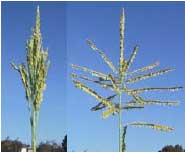|
January 19, 2006
Source:
American Society of Plant
Biologists
Ramosa2 determines cell fate in branch meristems of maize
Scientists are interested in
understanding genetic control of grass inflorescence
architecture because seeds of cereal grasses (e.g. rice, wheat,
maize) provide most of the world's food. Grass seeds are borne
on axillary branches, whose branching patterns dictate most of
the variation in form seen in the grasses. Maize produces two
types of inflorescence; the tassel (male pollen-bearing flowers)
and the ear (female flowers and site of seed or kernel
development). The tassel forms from the shoot apical meristem
after the production of a defined number of leaves, whereas ears
form at the tips of compact axillary branches. Normal maize ears
are unbranched, and tassels have long branches only at their
base.
 |
|
A ramosa2 tassel
(left) compared to a normal maize tassel (right) |
Many different genes control the
architecture as well as the nutrient content in cereal grasses.
The ramosa2 (ra2) mutant of maize has increased branching of
inflorescences relative to wild type plants, with short branches
replaced by long, indeterminate ones, suggesting that the ra2
gene plays an important role in controlling inflorescence
architecture. A recent publication in The Plant Cell (Bortiri et
al.) reports that ra2 encodes a putative transcription factor,
or protein that controls the expression of other genes.
Scientists involved in the study were Esteban Bortiri, George
Chuck, and Sarah Hake of the USDA Plant Gene Expression Center
and University of California at Berkeley and colleagues Erik
Vollbrecht of Iowa State University, Torbert Rocheford of the
University of Illinois, and Rob Martienssen of Cold Spring
Harbor Laboratory in New York.
The group found that the ra2 gene is transiently expressed early
in development of the maize inflorescence. Analysis of gene
expression in a number of different mutant backgrounds placed
ra2 function upstream of other genes that regulate branch
formation. The early expression of ra2 suggests that it
functions in regulating the patterning of stem cells in axillary
meristems.
Said Dr. Hake, "we think that ra2 is critical for shaping the
initial steps of inflorescence architecture in the grass family,
because the ra2 expression pattern is conserved in other grasses
including rice, barley, and sorghum".
Perspective: Branching Out: The ramosa Pathway and the
Evolution of Grass Inflorescence Morphology
In an accompanying Current Perspective Essay, Paula McSteen of
The Pennsylvania State University discusses the ramosa pathway
in the context of the evolution of plant development.
"The grasses are a premier model system for evolution of
development studies in higher plants: there is tremendous
diversity in inflorescence morphology, the phylogeny is well
understood and many species are genetically transformable so
hypotheses can be tested. Maize in particular is an excellent
model system for studying selection as it was domesticated from
its wild ancestor teosinte a mere 10,000 years ago.
Because transcription factors control many developmental
processes, it is common to find that diversification of
morphology between closely related organisms has involved
changes in how transcription factors are regulated or how
transcription factors interact with their target genes.
An understanding of the ramosa pathway in the grass family will
be important in understanding the evolution of the grasses and
furthermore will provide an understanding of the mechanisms of
evolution of development."
Dr. McSteen commented "because ra2 has increased branching it
might have the potential to lead to increased seed number and
yield in some cereal grasses. This might not be true for maize
because of the structure of the ear, but one can imagine that a
ra2 mutant of barley, rice or sorghum might have more branches,
and thus produce more seed".
The research paper cited in this report is available at
www.aspb.org/pressreleases/TPC039032.pdf
The accompanying Perspective Essay will be published in the
March issue of The Plant Cell. For preprints contact Nancy
Eckardt neckardt@aspb.org.
The Plant Cell is
published by the American Society of Plant Biologists. |